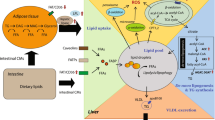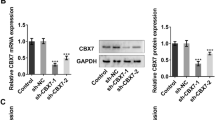Abstract
Objective
Peroxisome proliferator-activated receptor α (PPARα) activation has been reported to ameliorate liver injury in cases of acute liver failure (ALF). However, its intrinsic protective molecular mechanisms remain largely undetermined. C/EBP homologous protein (CHOP) is an important mediator of lipopolysaccharide (LPS)-induced inflammation. The aim of the present study was to test the hypothesis that PPARα activation alleviates liver inflammation to protect mice from acute liver failure (ALF) mediated by CHOP.
Methods
In a murine model induced by d-galactosamine (d-GalN, 700 mg/kg) and LPS (10 μg/kg), Wy-14643 (6 mg/kg) was administered to activate PPARα. The mice of different groups were killed 6 h after d-GalN/LPS injection, and the liver and blood were collected for analysis. To find out whether PPARα activation protects the liver from injury due to inflammation by regulating CHOP, we used expression plasmid to increase CHOP expression and demonstrated how PPARα mediated CHOP to regulate inflammation in vivo and in vitro.
Results
The expression of PPARα was downregulated and the expression of CHOP was upregulated with the development of d-GalN/LPS-induced liver injury. The protective molecular mechanisms of PPARα activation were dependent on the expression of CHOP. Indeed, (1) PPARα activation decreased the expression of CHOP; on the other hand, PPARα knockdown increased the expression of CHOP in vivo; (2) the depressed liver inflammation by PPARα activation was due to the downregulation of CHOP expression, because overexpression of CHOP by transfect plasmid reversed liver protection and increased liver inflammation again; (3) in vitro, PPARα inhibition by siRNA treatment increased the expression of proinflammatory cytokines, and CHOP siRNA co-transfection reversed the expression of proinflammatory cytokines.
Conclusions
Here, we demonstrated that PPARα activation contributes to liver protection and decreases liver inflammation in ALF, particularly through regulating CHOP. Our findings may provide a rationale for targeting PPARα as a potential therapeutic strategy to ameliorate ALF.





Similar content being viewed by others
Abbreviations
- ALF:
-
Acute liver failure
- ALT:
-
Alanine aminotransferase
- AST:
-
Aspartate aminotransferase
- ATF6α:
-
Activating transcription factor 6α
- BMDMs:
-
Murine bone marrow-derived macrophages
- CHOP:
-
C/EBP homologous protein
- CXCL-10:
-
Chemokine (C-X-C motif) ligand-10
- d-GalN:
-
d-Galactosamine
- ER:
-
Endoplasmic reticulum
- H&E:
-
Hematoxylin and eosin
- HPRT:
-
Hypoxanthine-guanine phosphoribosyltransferase
- IL-6:
-
Interleutin-6
- IRE1α:
-
Inositol-requiring kinase 1α
- LPS:
-
Lipopolysaccharide
- NF-κB:
-
Transcription factor nuclear factor-κB
- NOD:
-
Nucleotide-binding oligomerization domain
- PPARα:
-
Peroxisome proliferator-activated receptor-α
- PERK:
-
Pancreatic ER eIF2α kinase
- PVDF:
-
Polyvinylidene difluoride
- qRT-PCR:
-
Quantitative reverse transcription-PCR
- RIDD:
-
Regulated IRE1-dependent decay
- RIG-1:
-
Retinoic acid-inducible gene 1
- RIPA:
-
Radioimmunoprecipitation assay
- STAT1:
-
Signal transducer and activator of transcription 1
- TNF-α:
-
Tumor necrosis factor-α
- UPR:
-
Unfolded protein responses
References
Rolando N, Wade J, Davalos M, Wendon J, Philpott-Howard J, Williams R. The systemic inflammatory response syndrome in acute liver failure. Hepatology. 2000;32(4 Pt 1):734–9.
Hoofnagle JH, Carithers RL Jr, Shapiro C, Ascher N. Fulminant hepatic failure: summary of a workshop. Hepatology. 1995;21(1):240–52.
Desvergne B, Wahli W. Peroxisome proliferator-activated receptors: nuclear control of metabolism. Endocr Rev. 1999;20(5):649–88.
Kota BP, Huang TH, Roufogalis BD. An overview on biological mechanisms of PPARs. Pharmacol Res. 2005;51(2):85–94.
Staels B, Dallongeville J, Auwerx J, Schoonjans K, Leitersdorf E, Fruchart JC. Mechanism of action of fibrates on lipid and lipoprotein metabolism. Circulation. 1998;98(19):2088–93.
Roberts RA, Chevalier S, Hasmall SC, James NH, Cosulich SC, Macdonald N. PPAR alpha and the regulation of cell division and apoptosis. Toxicology. 2002;181–182:167–70.
Delayre-Orthez C, Becker J, Guenon I, Lagente V, Auwerx J, Frossard N, et al. PPARalpha downregulates airway inflammation induced by lipopolysaccharide in the mouse. Respir Res. 2005;6:91.
Di Paola R, Esposito E, Mazzon E, Genovese T, Muia C, Crisafulli C, et al. Absence of peroxisome proliferators-activated receptors (PPAR)alpha enhanced the multiple organ failure induced by zymosan. Shock. 2006;26(5):477–84.
Sheu MY, Fowler AJ, Kao J, Schmuth M, Schoonjans K, Auwerx J, et al. Topical peroxisome proliferator activated receptor-alpha activators reduce inflammation in irritant and allergic contact dermatitis models. J Invest Dermatol. 2002;118(1):94–101.
Yoo SH, Abdelmegeed MA, Song BJ. Activation of PPAR alpha by Wy-14643 ameliorates systemic lipopolysaccharide-induced acute lung injury. Biochem Biophys Res Commun. 2013;436(3):366–71.
Delerive P, De Bosscher K, Besnard S, Vanden Berghe W, Peters JM, Gonzalez FJ, et al. Peroxisome proliferator-activated receptor alpha negatively regulates the vascular inflammatory gene response by negative cross-talk with transcription factors NF-kappaB and AP-1. J Biol Chem. 1999;274(45):32048–54.
Lee JH, Joe EH, Jou I. PPAR-alpha activators suppress STAT1 inflammatory signaling in lipopolysaccharide-activated rat glia. NeuroReport. 2005;16(8):829–33.
Devchand PR, Keller H, Peters JM, Vazquez M, Gonzalez FJ, Wahli W. The PPARalpha-leukotriene B4 pathway to inflammation control. Nature. 1996;384(6604):39–43.
Standage SW, Caldwell CC, Zingarelli B, Wong HR. Reduced peroxisome proliferator-activated receptor alpha expression is associated with decreased survival and increased tissue bacterial load in sepsis. Shock. 2012;37(2):164–9.
Yoo SH, Park O, Henderson LE, Abdelmegeed MA, Moon KH, Song BJ. Lack of PPARalpha exacerbates lipopolysaccharide-induced liver toxicity through STAT1 inflammatory signaling and increased oxidative/nitrosative stress. Toxicol Lett. 2011;202(1):23–9.
Jiao M, Ren F, Zhou L, Zhang X, Zhang L, Wen T, et al. Peroxisome proliferator-activated receptor alpha activation attenuates the inflammatory response to protect the liver from acute failure by promoting the autophagy pathway. Cell Death Dis. 2014;5:e1397.
Kaufman RJ. Stress signaling from the lumen of the endoplasmic reticulum: coordination of gene transcriptional and translational controls. Genes Dev. 1999;13(10):1211–33.
Ron D, Walter P. Signal integration in the endoplasmic reticulum unfolded protein response. Nat Rev Mol Cell Biol. 2007;8(7):519–29.
Lin JH, Walter P, Yen TS. Endoplasmic reticulum stress in disease pathogenesis. Annu Rev Pathol. 2008;3:399–425.
Zhang K, Kaufman RJ. From endoplasmic-reticulum stress to the inflammatory response. Nature. 2008;454(7203):455–62.
Liu J, Ren F, Cheng Q, Bai L, Shen X, Gao F, et al. Endoplasmic reticulum stress modulates liver inflammatory immune response in the pathogenesis of liver ischemia and reperfusion injury. Transplantation. 2012;94(3):211–7.
Martinon F, Chen X, Lee AH, Glimcher LH. TLR activation of the transcription factor XBP1 regulates innate immune responses in macrophages. Nat Immunol. 2010;11(5):411–8.
Smith JA, Turner MJ, DeLay ML, Klenk EI, Sowders DP, Colbert RA. Endoplasmic reticulum stress and the unfolded protein response are linked to synergistic IFN-beta induction via X-box binding protein 1. Eur J Immunol. 2008;38(5):1194–203.
Zeng L, Liu YP, Sha H, Chen H, Qi L, Smith JA. XBP-1 couples endoplasmic reticulum stress to augmented IFN-beta induction via a cis-acting enhancer in macrophages. J Immunol. 2010;185(4):2324–30.
Kim I, Xu W, Reed JC. Cell death and endoplasmic reticulum stress: disease relevance and therapeutic opportunities. Nat Rev Drug Discov. 2008;7(12):1013–30.
Endo M, Oyadomari S, Suga M, Mori M, Gotoh T. The ER stress pathway involving CHOP is activated in the lungs of LPS-treated mice. J Biochem. 2005;138(4):501–7.
Endo M, Mori M, Akira S, Gotoh T. C/EBP homologous protein (CHOP) is crucial for the induction of caspase-11 and the pathogenesis of lipopolysaccharide-induced inflammation. J Immunol. 2006;176(10):6245–53.
Esposito V, Grosjean F, Tan J, Huang L, Zhu L, Chen J, et al. CHOP deficiency results in elevated lipopolysaccharide-induced inflammation and kidney injury. Am J Physiol Renal Physiol. 2013;304(4):F440–50.
Cao SS, Luo KL, Shi L. Endoplasmic reticulum stress interacts with inflammation in human diseases. J Cell Physiol. 2016;231(2):288–94.
Walter P, Ron D. The unfolded protein response: from stress pathway to homeostatic regulation. Science. 2011;334(6059):1081–6.
Zhang L, Ren F, Zhang X, Wang X, Shi H, Zhou L, et al. Peroxisome proliferator-activated receptor alpha acts as a mediator of endoplasmic reticulum stress-induced hepatocyte apoptosis in acute liver failure. Dis Model Mech. 2016;9(7):799–809.
Urano F, Wang X, Bertolotti A, Zhang Y, Chung P, Harding HP, et al. Coupling of stress in the ER to activation of JNK protein kinases by transmembrane protein kinase IRE1. Science. 2000;287(5453):664–6.
Keestra-Gounder AM, Byndloss MX, Seyffert N, Young BM, Chavez-Arroyo A, Tsai AY, et al. NOD1 and NOD2 signalling links ER stress with inflammation. Nature. 2016;532(7599):394–7.
Lencer WI, DeLuca H, Grey MJ, Cho JA. Innate immunity at mucosal surfaces: the IRE1-RIDD-RIG-I pathway. Trends Immunol. 2015;36(7):401–9.
Ren F, Zhou L, Zhang X, Wen T, Shi H, Xie B, et al. Endoplasmic reticulum stress-activated glycogen synthase kinase 3beta aggravates liver inflammation and hepatotoxicity in mice with acute liver failure. Inflammation. 2015;38(3):1151–65.
Acknowledgements
This work was supported by the National Natural Science Foundation of China (nos. 81270532, 81372094 and 81473500), the Natural Science Foundation of Beijing Municipality (no. 7162085), Beijing Municipal Science & Technology Commission Applied Research for the Clinical Characteristics of Capital (no. Z161100000516113), the Wang Boen Liver Fibrosis Research Foundation of CFHPC (no. CFHPC20131031), and the High-level Technical Personnel Training Plan of the Beijing Health System (no. 2013-3-075).
Author information
Authors and Affiliations
Contributions
XL and FR conceived and designed the work. XZ and PD performed the experiments. HS and HS contributed reagents/materials/analysis tools. DC and ZD participated in the discussion of the study.
Corresponding author
Ethics declarations
Conflict of interest
The authors declare no conflicts of interest.
Additional information
Responsible Editor: Liwu Li.
Rights and permissions
About this article
Cite this article
Zhang, X., Dong, P., Shi, H. et al. Peroxisome proliferator-activated receptor alpha mediates C/EBP homologous protein to protect mice from acute liver failure. Inflamm. Res. 66, 813–822 (2017). https://doi.org/10.1007/s00011-017-1061-3
Received:
Revised:
Accepted:
Published:
Issue Date:
DOI: https://doi.org/10.1007/s00011-017-1061-3




